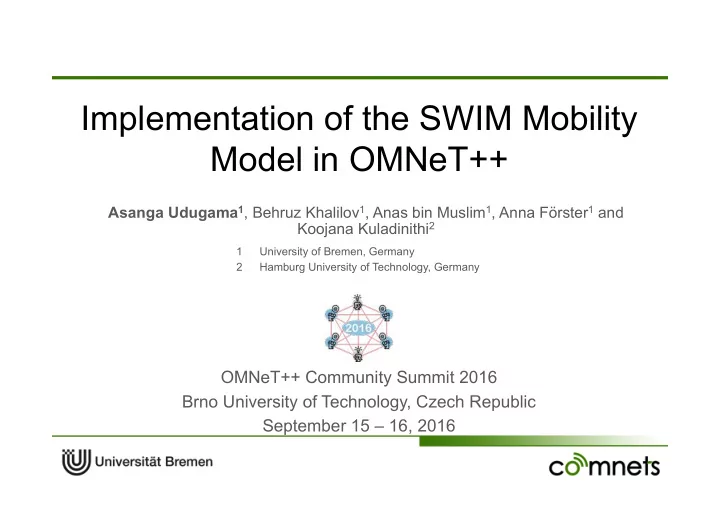

Implementation of the SWIM Mobility Model in OMNeT++ Asanga Udugama 1 , Behruz Khalilov 1 , Anas bin Muslim 1 , Anna Förster 1 and Koojana Kuladinithi 2 1 University of Bremen, Germany 2 Hamburg University of Technology, Germany OMNeT++ Community Summit 2016 Brno University of Technology, Czech Republic September 15 – 16, 2016
Contents Motivation SWIM Mobility Model Mobility Models in OMNeT++ SWIM Implementation in OMNeT++ Evaluations Summary and Future Work 2
Motivation 3
Motivation Internet of Things (IoT) Over 200 billion devices by 2020 [1] Focus of research Opportunistic Networking IoT Scenarios Many human oriented scenarios e.g., Smartphone user enabling health monitoring Nature of human oriented Scenarios Mobile users Scale of Devices in the IoT - Large Require simulators – OMNeT++ 4
Motivation OMNeT++ has a number of Mobility Models Random Way Point, Random Direction, etc. Human mobility has different characteristics Small Worlds in Motion (SWIM) is a Mobility Model that captures these characteristics [2] Focus: Develop the SWIM Model to simulate human oriented scenarios Useful for the OMNeT++ community 5
SWIM Mobility Model * * A. Mei and J. Stefa, SWIM: A Simple Model to Generate Small Mobile Worlds , IEEE INFOCOM, 2009 6
SWIM Based on 2 intuitions of human mobility Regularly visited locations are near to home and, A far location is visited due to its popularity Categorizes locations as, Home (Neighboring) location Visiting locations Next location selection based on weights w ( C ) = α · distance ( h A , C ) + (1 − α ) · seen ( C ) • w ( C ) - weight assigned to cell C by node A ; • distance ( h A , C ) - function of distance from node A to cell C ; • seen ( C ) - number of nodes that node A encountered at cell C ; • α - constant in the range of [0; 1]. 7
SWIM contd … Weight function Increases with popularity of a place, Decreases with the distance from the home location Empirically verified 8
Mobility Models in OMNeT++ 9
Mobility Models in OMNeT++ OMNeT++ has a number of models Available in the INET framework Simulation of mobility – using 2 methodologies Synthetic models – artificially generated mobility patterns Traces – mobility pattern data collected from actual movements Synthetic Models – classified based on the nature of movement Deterministic models – devoid of stochasticity Random models – stochasitic movement patterns SWIM – Synthetic model with random destination selection 10
Mobility Architecture in OMNeT++ IMobility Interface – implemented by mobility models Other models invoke methods in interface to obtain information OMNeT++ Base Mobility Implementations Extensible classes to include mobility model specific functionality e.g., LinearSegmentsMobilityBase – linear movement and moves in segments SWIM – Extends the LinearSegmentsMobilityBase model 11
SWIM Implementation in OMNeT++ 12
SWIM Implementation Requirements Basic functionality required Constant speed of mobility, Linear movements SWIM extends LineSegmentsMobilityBase Functionality separation in a node Initialization Phase – setup activities Mobility Phase – activities related to movement of node 13
SWIM Implementation Flow Chart Start Initialization Phase Simulation Create and load locations Create Locations No Locations (i.e., Grid the Decide node’s own position Initialisation Phase Created? network Yes Identify location separation Decide Node’s Load Locations Own Position Mobility Phase Identify Location Separation (Home, Neighbouring and Decide next destination and pause time Visiting) Move Decide Next Destination Location and the Position within that Location to move to (also handle Pause Time wait) Update node counts Mobility Phase Update Node Yes Signal Counts at Move Received? Locations No No Reached Destination? Yes End Simulation 14
SWIM Configurable Parameters neighbourLocationLimit – distance to determine location separation noOfLocations – locations to create from movement area alpha – SWIM α value initialX , initialY , initialZ – initial coordinates of a node maxAreaX , maxAreaY , maxAreaZ – movement area waitTime – pause time after reaching a destination speed – velocity of node when moving 15
Evaluations 16
Evaluations Focused on how destinations are selected Emphasis on Visiting Locations (lower α ) Emphasis on Neighboring Locations (higher α ) 400 400 350 350 300 300 250 250 Y (meters) Y (meters) 200 200 150 150 100 100 50 50 0 0 0 50 100 150 200 250 300 350 400 0 50 100 150 200 250 300 350 400 X (meters) X (meters) Home Neighboring Locations Home Neighboring Locations Visiting locations Mobility Visiting locations Mobility 17
Summary and Future Work 18
Summary SWIM – an empirically validated mathematical model to model human mobility, proposed by authors of [2] Based on 2 intuitions related to human mobility Regularly travelled locations lie close to home Further locations are visited due to their popularity Purpose of this work – implementation of the SWIM model in OMNeT++ Currently available at Github (search: SWIM mobility ) 19
Future Work Our work with SWIM – use in opportunistic networks Organic Data Dissemination (ODD) – Communication Model ([3]) Opportunistic networks Internet of Things ODD – Currently as an OMNeT++ model SWIM is ideally suited for evaluating ODD – but not all scenarios Key lacking area – reactiveness Destinations change (while in motion) due to external events e.g., an emergency, change of plans 20
References 21
References [1] IDC IVIEW, Digital Universe in 2020 , December 2012 [2] A. Mei and J. Stefa, SWIM: A Simple Model to Generate Small Mobile Worlds , IEEE INFOCOM, 2009 [3] A. Foerster et al, A Novel Data Dissemination Model for Organic Data Flows , MONAMI 2015, September 2015, Santander Spain 22
Thank You. Questions? 23
Recommend
More recommend